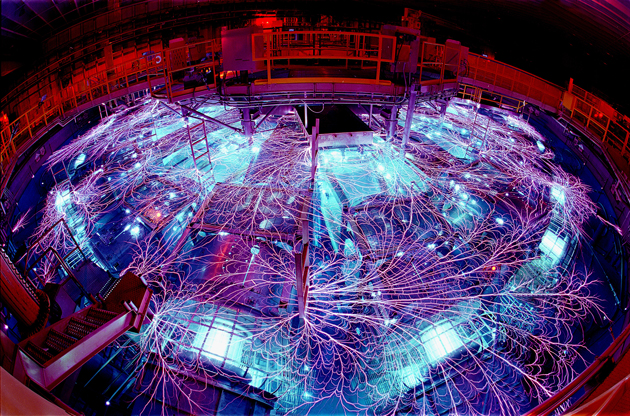Scientists in the US (Sandia Labs) and Germany (Max Planck Institute for Chemistry) have successfully transformed liquid deuterium into a metal at pressures rivalling those at the center of our own planet. The discovery is another step along the long road to obtaining solid metallic hydrogen, a phase of matter that has eluded scientists for 80 years.
Recent efforts by a team based at the Max Planck Institute for Chemistry, Germany, using a diamond anvil cell (DAC), where a compound is compressed between two flattened diamond tips, have revealed that it is indeed possible for hydrogen-rich compounds to adopt a metallic character.
But there are limits to what a DAC can achieve according to Marcus Knudson from the Sandia National Laboratories, US, whose team carried out the new research on deuterium. ‘DAC techniques can achieve around 200GPa pressures, but hydrogen at high pressures becomes extremely reactive,’ says Knudson. He explains that this reactivity makes it nearly impossible to conduct experiments under the diamond anvil.
Knudson and his colleagues have adopted a different approach by using shockwaves to compress liquid deuterium at the Sandia Z machine, a power generator capable of producing magnetic fields with a strength of up to 20 mega gauss – six orders of magnitude larger than the Earth’s magnetic field.
The team initially condensed deuterium gas at 20K in an aluminium cryocell. Once the liquid had been produced, a pulsed current from the Z machine was passed through an electrode, which struck the front of the cyrocell to produce a pulsed shockwave.
By exploiting these shockwaves to slowly compress the liquid, the team analysed how well the deuterium reflected light as the pressure was ramped up. At low pressures the deuterium was transparent, but it suddenly began to reflect light at about 300GPa.
This abrupt change in the hydrogen isotope’s optical properties is a typical indicator of an insulator-to-metal transition, according to Knudson. He goes on to explain that such a finding will be crucial in our understanding of the evolution of planets and stars, where hydrogen metallisation can be linked to the pressure and temperature profiles of planetary cores.
Sandia’s Z machine can produce a magnetic field six order of magnitude larger than that of the Earth © Randy Montoya / Sandia Labs (CC BY-NC-ND 2.0)
Science -Direct observation of an abrupt insulator-to-metal transition in dense liquid deuterium
Abstract
Eighty years ago, it was proposed that solid hydrogen would become metallic at sufficiently high density. Despite numerous investigations, this transition has not yet been experimentally observed. More recently, there has been much interest in the analog of this predicted metallic transition in the dense liquid, due to its relevance to planetary science. Here, we show direct observation of an abrupt insulator-to-metal transition in dense liquid deuterium. Experimental determination of the location of this transition provides a much-needed benchmark for theory and may constrain the region of hydrogen-helium immiscibility and the boundary-layer pressure in standard models of the internal structure of gas-giant planets.
Editors Summary -Driving liquid deuterium into metal
Quick and powerful compression can force materials to change their properties dramatically. Knudson et al. compressed liquid deuterium to extreme temperatures and pressures using high-energy magnetic pulses at the Sandia Z-machine (see the Perspective by Ackland). Deuterium began to reflect like a mirror during compression, as the electrical conductivity sharply increased. The observed conditions for metallization of deuterium and hydrogen help us to build theoretical models for the universe’s most abundant element. This a our understanding of the internal layering of gas giant planets such as Jupiter and Saturn
41 pages of supplemental material
SOURCES – Science, Sandia, Chemistry World

Brian Wang is a Futurist Thought Leader and a popular Science blogger with 1 million readers per month. His blog Nextbigfuture.com is ranked #1 Science News Blog. It covers many disruptive technology and trends including Space, Robotics, Artificial Intelligence, Medicine, Anti-aging Biotechnology, and Nanotechnology.
Known for identifying cutting edge technologies, he is currently a Co-Founder of a startup and fundraiser for high potential early-stage companies. He is the Head of Research for Allocations for deep technology investments and an Angel Investor at Space Angels.
A frequent speaker at corporations, he has been a TEDx speaker, a Singularity University speaker and guest at numerous interviews for radio and podcasts. He is open to public speaking and advising engagements.



